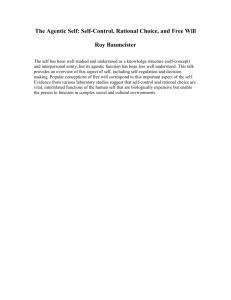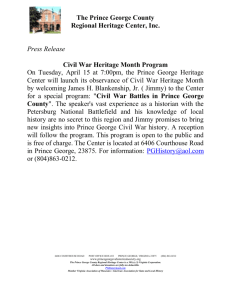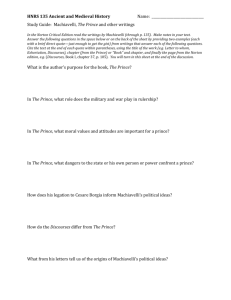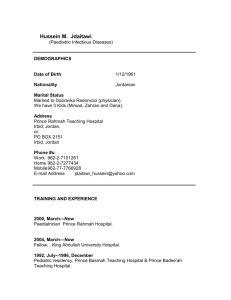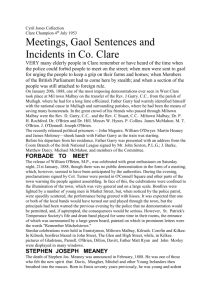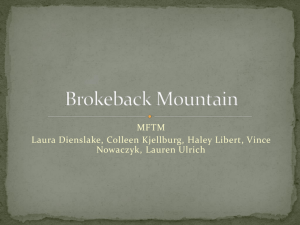Critical Thinking in the Workplace
advertisement
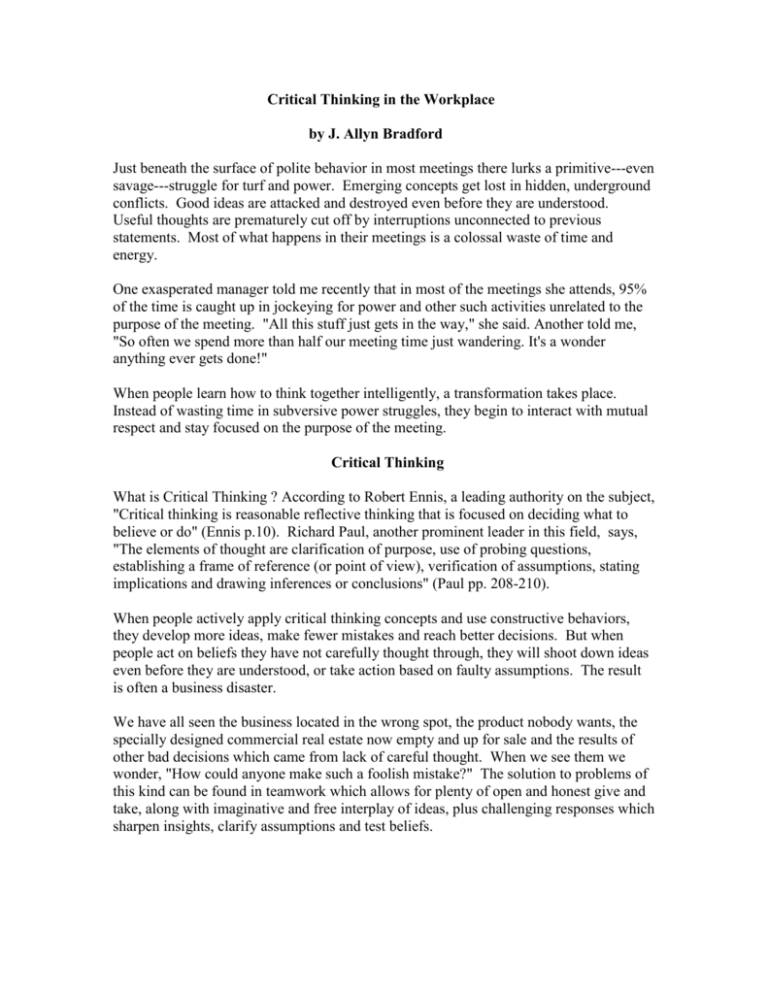
Critical Thinking in the Workplace by J. Allyn Bradford Just beneath the surface of polite behavior in most meetings there lurks a primitive---even savage---struggle for turf and power. Emerging concepts get lost in hidden, underground conflicts. Good ideas are attacked and destroyed even before they are understood. Useful thoughts are prematurely cut off by interruptions unconnected to previous statements. Most of what happens in their meetings is a colossal waste of time and energy. One exasperated manager told me recently that in most of the meetings she attends, 95% of the time is caught up in jockeying for power and other such activities unrelated to the purpose of the meeting. "All this stuff just gets in the way," she said. Another told me, "So often we spend more than half our meeting time just wandering. It's a wonder anything ever gets done!" When people learn how to think together intelligently, a transformation takes place. Instead of wasting time in subversive power struggles, they begin to interact with mutual respect and stay focused on the purpose of the meeting. Critical Thinking What is Critical Thinking ? According to Robert Ennis, a leading authority on the subject, "Critical thinking is reasonable reflective thinking that is focused on deciding what to believe or do" (Ennis p.10). Richard Paul, another prominent leader in this field, says, "The elements of thought are clarification of purpose, use of probing questions, establishing a frame of reference (or point of view), verification of assumptions, stating implications and drawing inferences or conclusions" (Paul pp. 208-210). When people actively apply critical thinking concepts and use constructive behaviors, they develop more ideas, make fewer mistakes and reach better decisions. But when people act on beliefs they have not carefully thought through, they will shoot down ideas even before they are understood, or take action based on faulty assumptions. The result is often a business disaster. We have all seen the business located in the wrong spot, the product nobody wants, the specially designed commercial real estate now empty and up for sale and the results of other bad decisions which came from lack of careful thought. When we see them we wonder, "How could anyone make such a foolish mistake?" The solution to problems of this kind can be found in teamwork which allows for plenty of open and honest give and take, along with imaginative and free interplay of ideas, plus challenging responses which sharpen insights, clarify assumptions and test beliefs. What about Creative Thinking? As for creative thinking, George Prince, one of the masters of this art, says that for creativity take place we need to "be optimistic, assume valuable implications, protect vulnerable beginnings, give early support, share the risk, deal as an equal, temporarily suspend disbelief, share the burden of proof, focus on what is going for an idea and assume it can be done" (Prince and Prince p.12). Creative thinking is really an integral part of critical thinking and vice versa. They are like two sides of the same coin. Teams Can Learn to Think Critically Teams, as well as individuals, can learn how to think more effectively and consequently get better results. Of course, changes or improvements in the way teams think does not happen overnight. But with sufficient coaching and practice, teams can gradually change as they learn to apply really sound thinking concepts in meetings and in everyday situations. This can happen in team sports, as a team goes from the awkwardness of early training to high performance later in the season. For such a transformation to occur in a business a team must learn to think together. It requires good listening for this to happen. This is not the kind of listening that just identifies the flaw or weakness in a statement that is used in a power struggle. Rather it means listening with empathy to understand the thoughts a person is trying to develop. When another person’s ideas are fully understood, the strengths and weaknesses can be sorted out and then the whole thing can built up into something viable and for the benefit of everyone involved. Good thinking can hardly take place in an atmosphere that is rife with conflict and antagonism. If people shout accusations at each other, there is little chance for a reasonable approach. And though conflict usually happens more subtly than in a shouting match, the effect is the same. For reason to prevail, it is essential to have an environment that is conducive to critical and creative thinking. Validation Builds Team Rapport Productive meetings don't just happen. They require leadership facilitation which is sensitive to the need for a climate in which a rational and creative group process can take place. Meetings needs such leadership just as in a family, a parent is needed to keep the bigger kids from squelching the littler ones. No matter how politely they are done, put-downs are put-downs and will always have a negative effect. For example, when someone says something like "Tom, just doesn’t understand", Tom will resent it and withdraw because he feels discounted. Negative statements like that reduce motivation and commitment. This is not to say that critical thinking needs to be set aside. But critical thinking does not attack people. It attacks problems and issues. When a people learn how to work together well by using behaviors that support a rational process, trust builds and along with it a sense of mutual acceptance, validation and support. Working together can then become meaningful---and even fun---because members feel accepted and valued. Creative and rational activity expand when people feel safe from ridicule and know they no longer have to keep a low profile for fear of getting shot down. The use of critical and creative thinking enables teams to develop the positive insights and ideas that become the constructive basis for action. Not only will you team be happier and more motivated if you use the concepts and behaviors described above, but you will also have shorter and more effective meetings. Sources: Robert J. Ennis, "A Taxonomy of Critical Thinking Dispositions and Abilities", pp.9-26, in Baron and Sternberg, Teaching Thinking Skills: Theory and Practice, 1987, W.H. Freeman and Company, New York. Richard W. Paul, Critical Thinking, How to Prepare Students for a Rapidly Changing World,1993, Foundation for Critical Thinking, Santa Rosa, CA. George Prince and Kathleen Logan-Prince, Your Life is a Series of Meeting, 1998, 1st Books Library




